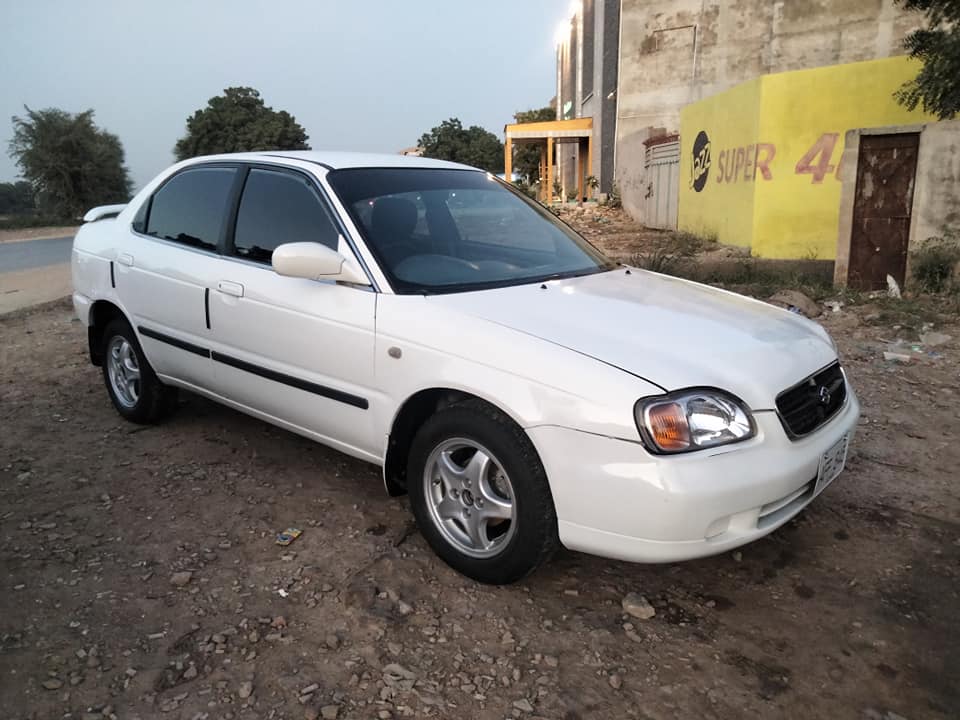Not many know that Suzuki Baleno was the most technically advanced locally assembled vehicle of its time in our market. Not only this, it remained so throughout its 8-year production period in the country.
When launched, it was the first Pak Suzuki vehicle to be offered in metallic colors & matching bumpers, it was the first 1300cc car in our market to offer an Electronic Fuel Injection system (EFI). For a limited period, it was also available with a 1.6L engine in the GTi trims. Baleno was the first Suzuki model to carry a true facelift in 2002. It was also the first 1300cc vehicle in our market to come equipped with an engine immobilizer (in the facelift models).

Baleno was introduced in 1998 as a replacement for the Suzuki Margalla, primarily to compete against the Honda City SX8 which was launched a year ago in 1997 and was available with a carburetor-based 1.3L and a fuel-injected 1.5L version called the Neo. In comparison to the Margalla, which was the best example of straightforward engineering, the Baleno was a slew of tech gadgetry that was unusual even to the men at Suzuki 3S.
Related: Pak Suzuki And The Sedan Segment
Suzuki Baleno was available in an exciting range of colors (more than 12), and most number of variants (EL, GLi, GLiP, GXi in pre-facelift and JXR, JXR CNG, JXL, and JXL CNG in facelift) compared to any locally assembled car in Pakistan.

The Baleno’s worst misfortune was that, unlike other Suzuki vehicles, which are seldom required to face a competitor, the Baleno was always up against some vehement competition. It was the Honda City SX8 pre-facelift in its early days, which was then replaced by the facelift in the year 2000, something which is remembered as the most aggressive-looking and loved model of Honda City in Pakistan.
Related: The Suzuki Fronte 800 from the 1960s
And in 2002, when Suzuki unveiled the Baleno facelift, it was overshadowed by the introduction of the 9th generation Toyota Corolla, which came almost a decade after the very lengthy stay of the 7th generation Corolla and instantly became the talk of the town.

The Baleno tenure spanned 8 years in Pakistan with the Liana coming as a replacement in 2005/06. Not to mention, Baleno’s prime rival the Honda City was already upgraded to the 4th gen iDSI model in 2003 and was blessed with a facelift in mid-2006. Hence Liana was up against the City iDSI when it arrived.
Related: From Hero to Zero
Although Liana was on sale for a decade in Pakistan, it severely struggled to leave the showroom floors apart from the initial two years of sales in the country. Not many know that Baleno in its 8 years of production sold 23,302 units (averaging 2,912 units a year, or 242 units a month) compared to 16,765 units of Liana (averaging 1,676 units a year, or 139 units a month) during 10 years of its lifespan.

Interestingly, Liana in its last 8 years of production sold 6,127 units (averaging just 765 units a year) while it sold 6,067 units in 2006-07 alone. Liana in its last 3 years of production saw just 164 units, 161 units, and 23 units sold (averaging 13.6, 13.4, and 1.9 units a month, respectively) the worst numbers for any locally assembled car in Pakistan.
Related: Suzuki Ciaz- You Will be Missed…
Pak Suzuki has never tasted true success in the sedan segment after the demise of the 1.3L Margalla which was assembled between 1991 and 1998. Before that, its Japan-assembled version with a 1.0L engine called the Swift sedan was on sale. After Liana, Pak Suzuki introduced the Kizashi as well as Ciaz (both as CBU imported models) however both of these cars were unable to create any impression in the market, despite some spoon-fed claims of having smashed the critics straight after the launch.

According to PAMA (Pakistan Automobile Manufacturers Association), Margalla sales in FY1995-96 stood at 6,028 units which were cut into half at 3,174 and 3,074 units in FY1996-97 and FY1997-98 respectively (after the arrival of Honda City SX8), but numbers before FY1995-96 aren’t available on PAMA data. It is nevertheless believed that the sales of Margalla during its era were higher than that of Baleno, as even the affected sales of the last two years of Margalla (3,000+ units a year) were still higher than the yearly sales average of Baleno (around 2,900 units).
Related: Remembering Suzuki Margalla
But according to the numbers we have, it is evident that the sales of Baleno weren’t that impressive (avg 242 units a month) but nevertheless, it was way more successful than Liana with its 8-year sales standing 39% higher than the 10 years sales of the latter. By the time the Suzuki Baleno facelift was discontinued in 2005/06, it was priced as:
| BALENO JXR | Rs. 749,000 |
| BALENO JXR (CNG) | Rs. 789,000 |
| BALENO JXL | Rs. 809,000 |
| BALENO JXL (CNG) | Rs. 849,000 |
Do you have any ownership experience of Suzuki Baleno, feel free to share it with us using the comment section below.


A computer animation professional with over 23 years of industry experience having served in leading organizations, TV channels & production facilities in Pakistan. An avid car enthusiast and petrolhead with an affection to deliver quality content to help shape opinions. Formerly written for PakWheels as well as major publications including Dawn. Founder of CarSpiritPK.com




